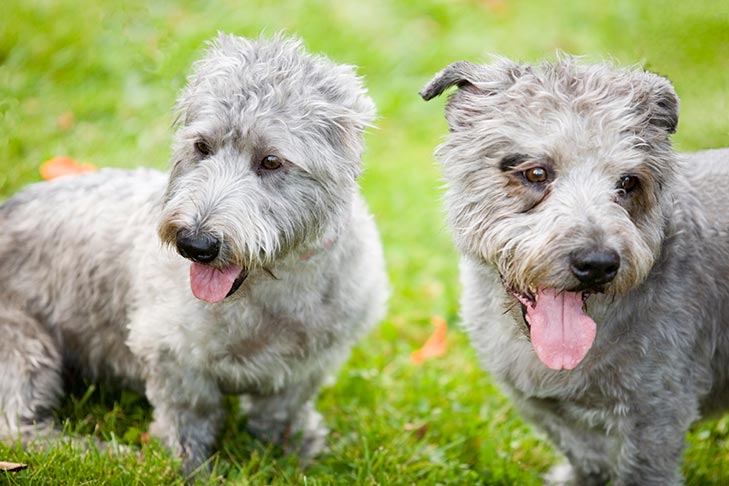
AKC is a participant in affiliate advertising programs designed to provide a means for sites to earn advertising fees by advertising and linking to akc.org. If you purchase a product through this article, we may receive a portion of the sale.
Summer means ice cream, hikes in the woods with your dog, swimming in ponds, running through fields, and generally having a ball while soaking up the warmth.
All that fun in the sun can have a downside, though. Most people are aware of the more obvious hazards that come with long, warm days — heat stroke, drowning, disease-spreading mosquitoes, and fleas and ticks. But here are some other hazards that may not be on your radar screen.
Foxtails and Other “Mean Seeds”
“Mean seeds” is a term that has been coined to refer to foxtails or any number of plants, including Canada wild rye and cheatgrass, that have barbed grass awns or seed heads. Dogs may pick up a grass awn on an ear, eye, mouth, nose, or between their toes – and awns can even burrow directly into their skin. These plants and seeds can be particularly dangerous, causing pneumonia if the dog inhales them. The shape of the barbs allows the seed to continuously move forward, traveling inside the dog from the nose to the brain or into a lung, and spreading bacteria that cause infections.
Disease caused by grass awns is a growing problem among hunting dogs. But any dog can come in contact with these plants when running or walking through tall grass, since grass awns are common throughout North America, especially from May through December. Dogs with long ears and coats may be more likely to pick up the barbs.
Embedded foxtails are painful. Your dog may have an embedded foxtail or similar barbed awn if you see these symptoms:
- Swelling between the toes, limping, or licking one area of the foot
- Scratching at an ear and/or tilting or shaking their head
- Pawing at an eye that is red, swollen, or has a discharge
- Frequent sneezing and nasal discharge, as well as repetitive sneezing and coughing
- Persistent licking of the genitals

Preventing Problems Caused by Foxtails and Other Barbed Awns
- Keep your yard clear of foxtails and other tall grasses.
- Trim your dog’s hair during foxtail season.
- Avoid taking your dog to areas or hiking trails where you see foxtails or any overgrown fields of tall grasses.
- If you do walk through any area where foxtails are growing, check your dog for visible seeds, especially between the toes. Run a fine-toothed comb through their coat and look for awns in their fur. Also, check the ears, face, and mouth. Remove awns before they start to burrow with a brush or tweezers.
- If the awn is embedded and surrounded by red and swollen skin, take the dog to your veterinarian.
- If your dog starts to exhibit strange symptoms of illness, especially sneezing or breathing problems, see your veterinarian right away and mention that you’ve been in a place where foxtails were growing.
- If there’s a strong chance you won’t be able to avoid locations where foxtails grow when you’re out hiking or hunting with your dog, consider covering their paws with dog booties.
Toxic Algae
Algae are a normal part of the ecosystem of ponds, lakes, and other bodies of water, including fresh and salt water. Algae can even grow in swimming pools that aren’t cleaned frequently. However, some varieties of blue-green algae, also known as cyanobacteria, are toxic and often fatal to dogs, causing damage to skin, liver, and nervous system.
They are most dangerous in a form called a “bloom,” which is easy to spot. Blooms will have a horrible odor and a distinctive appearance, looking most often like green paint or pea soup. Toxic algae blooms can also be brown and red.
Cyanobacteria can also affect people. Most people will avoid a dip in a swimming hole that looks like a pot of stinky pea soup, but dogs love that kind of stuff and will dive right in. Within the last few years, dogs have died after swimming in waters infested with blue-green algae, mainly in the southern United States but also in Colorado and Minnesota. Licking their paws after just walking in the algae can even poison dogs.
Toxic blue-green algae prefer warmer water, and the Environmental Protection Agency reports that climate change and the resulting warmer water may increase the occurrence and threat of blue-green algae. In 2019, blue-green mats of algae blanketed more than 1,500 square kilometers of Lake Erie’s surface by August, toxic algae forced officials to close New Jersey’s largest lake to recreational activities, and officials in North Carolina and Georgia warned dog owners to keep their pets out of the water after at least four dogs died swimming in contaminated water.
Symptoms of Blue-Green Algae Toxicity
Symptoms of blue-green algae toxicity can occur within a few minutes to a few hours of exposure, and dogs can die within one hour. These symptoms include:
- Vomiting and diarrhea
- Bloody or black, tarry stool
- Pale gums
- Muscle tremors and seizures
- Excessive salivation
- Difficulty breathing
- Shock and coma
According to Dr. Jerry Klein, Chief Veterinary Officer for the AKC, there is no antidote for the toxins created by blue-green algae. “It’s especially important to avoid bodies of water that are infected, and if your dog does swim in an infected area, seek immediate veterinary care. Dogs who recover may have long-term liver damage or other complications. It can depend on the type of toxin, size of the dog, how much he has ingested, and how quickly he is treated.”

Before you and your dog go swimming, it’s a good idea to check the website of your state’s natural resources agency to find out where blue-green algae is a problem. Here are some other tips to prevent blue-green algae poisoning:
- Keep your dog leashed around bodies of water.
- Don’t let your dog drink out of ponds and lakes.
- Err on the side of caution. If you see suspicious-looking algae in the water, keep your dog out.
- Rinse the dog off with fresh water if they come in contact with blue-green algae (wash your hands or use gloves) and take them to the veterinarian immediately.
- Watch for symptoms including vomiting, diarrhea, seizures, jaundice, and rashes.
Sea Grant, New York offers a very helpful brochure called “Dogs and Harmful Algal Blooms.”
Myiasis (Maggot Infestation)
Flies reproduce by laying eggs, which hatch and release maggots. Myiasis is an infestation of the maggot larvae of flies. This condition may occur with neglected dogs who are tied up outside, but it can also infest well-cared-for pets. It can arise so quickly — it takes less than 48 hours for larvae to hatch and reach a size of about a grain of rice.
Elderly and incontinent dogs, or those with open wounds or bacterial skin infections, are most susceptible because certain odors will attract flies. The flies will land on the dog and lay eggs. When the larvae emerge, they’ll hook on to the skin and start to feed, resulting in serious lesions.

“If you suspect myiasis, get to a veterinarian as soon as possible,” says Dr. Klein. “Treatment will include manually removing the maggots, which sometimes requires shaving hair at the site, application of a topical insecticide, and oral antibiotic medication often for several weeks.”
Prevention is the wisest route, and it entails keeping a dog indoors if they have wounds or other obvious conditions that might attract flies. Keep wounds clean and be sure to have skin problems treated by a veterinarian. If your dog is old or incontinent, keep them inside and keep their coat clean of urine and feces. And if you see flies buzzing around your pet, shoo them away.

